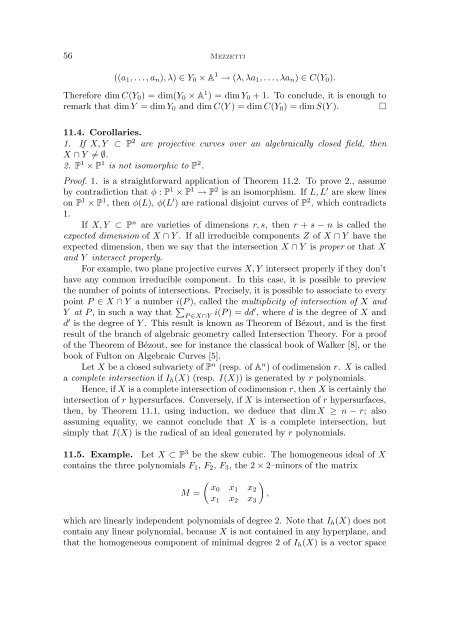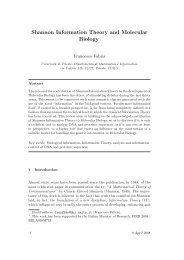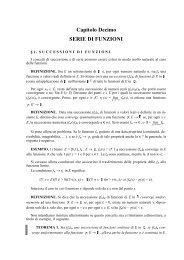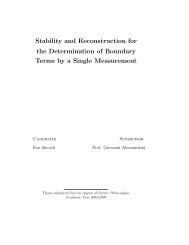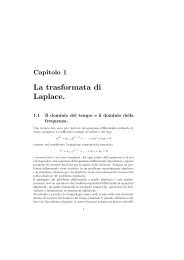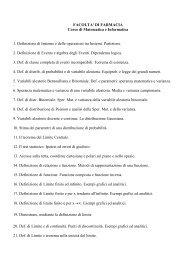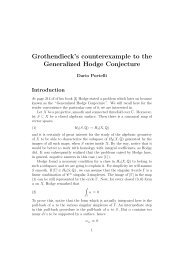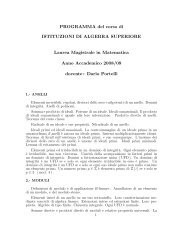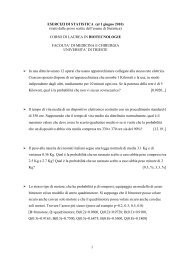INTRODUCTION TO ALGEBRAIC GEOMETRY Note del corso di ...
INTRODUCTION TO ALGEBRAIC GEOMETRY Note del corso di ...
INTRODUCTION TO ALGEBRAIC GEOMETRY Note del corso di ...
Create successful ePaper yourself
Turn your PDF publications into a flip-book with our unique Google optimized e-Paper software.
56 Mezzetti((a 1 , . . ., a n ), λ) ∈ Y 0 × A 1 → (λ, λa 1 , . . ., λa n ) ∈ C(Y 0 ).Therefore <strong>di</strong>m C(Y 0 ) = <strong>di</strong>m(Y 0 × A 1 ) = <strong>di</strong>mY 0 + 1. To conclude, it is enough toremark that <strong>di</strong>m Y = <strong>di</strong>mY 0 and <strong>di</strong>m C(Y ) = <strong>di</strong>m C(Y 0 ) = <strong>di</strong>m S(Y ). □11.4. Corollaries.1. If X, Y ⊂ P 2 are projective curves over an algebraically closed field, thenX ∩ Y ≠ ∅.2. P 1 × P 1 is not isomorphic to P 2 .Proof. 1. is a straightforward application of Theorem 11.2. To prove 2., assumeby contra<strong>di</strong>ction that φ : P 1 × P 1 → P 2 is an isomorphism. If L, L ′ are skew lineson P 1 × P 1 , then φ(L), φ(L ′ ) are rational <strong>di</strong>sjoint curves of P 2 , which contra<strong>di</strong>cts1.If X, Y ⊂ P n are varieties of <strong>di</strong>mensions r, s, then r + s − n is called theexpected <strong>di</strong>mension of X ∩ Y . If all irreducible components Z of X ∩ Y have theexpected <strong>di</strong>mension, then we say that the intersection X ∩ Y is proper or that Xand Y intersect properly.For example, two plane projective curves X, Y intersect properly if they don’thave any common irreducible component. In this case, it is possible to previewthe number of points of intersections. Precisely, it is possible to associate to everypoint P ∈ X ∩ Y a number i(P), called the multiplicity of intersection of X andY at P, in such a way that ∑ P ∈X∩Y i(P) = dd′ , where d is the degree of X andd ′ is the degree of Y . This result is known as Theorem of Bézout, and is the firstresult of the branch of algebraic geometry called Intersection Theory. For a proofof the Theorem of Bézout, see for instance the classical book of Walker [8], or thebook of Fulton on Algebraic Curves [5].Let X be a closed subvariety of P n (resp. of A n ) of co<strong>di</strong>mension r. X is calleda complete intersection if I h (X) (resp. I(X)) is generated by r polynomials.Hence, if X is a complete intersection of co<strong>di</strong>mension r, then X is certainly theintersection of r hypersurfaces. Conversely, if X is intersection of r hypersurfaces,then, by Theorem 11.1, using induction, we deduce that <strong>di</strong>mX ≥ n − r; alsoassuming equality, we cannot conclude that X is a complete intersection, butsimply that I(X) is the ra<strong>di</strong>cal of an ideal generated by r polynomials.11.5. Example. Let X ⊂ P 3 be the skew cubic. The homogeneous ideal of Xcontains the three polynomials F 1 , F 2 , F 3 , the 2 × 2–minors of the matrixM =( )x0 x 1 x 2,x 1 x 2 x 3which are linearly independent polynomials of degree 2. <strong>Note</strong> that I h (X) does notcontain any linear polynomial, because X is not contained in any hyperplane, andthat the homogeneous component of minimal degree 2 of I h (X) is a vector space


